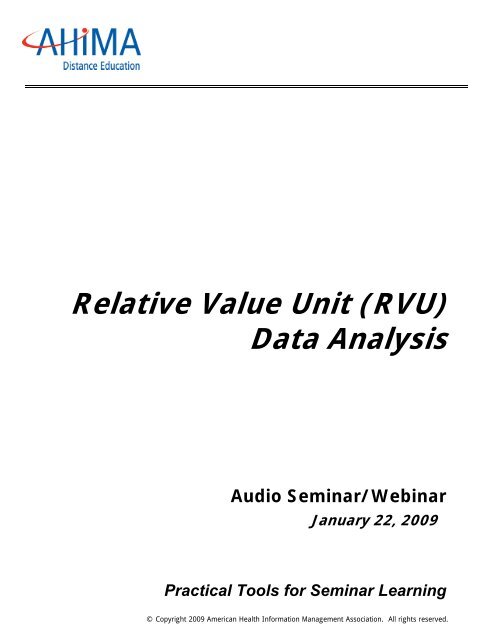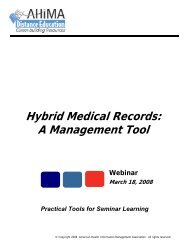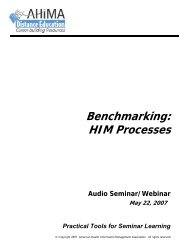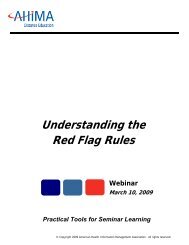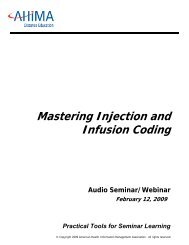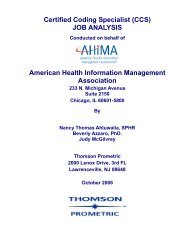Relative Value Unit (RVU) - American Health Information ...
Relative Value Unit (RVU) - American Health Information ...
Relative Value Unit (RVU) - American Health Information ...
Create successful ePaper yourself
Turn your PDF publications into a flip-book with our unique Google optimized e-Paper software.
<strong>Relative</strong> <strong>Value</strong> <strong>Unit</strong> (<strong>RVU</strong>)<br />
Data Analysis<br />
Audio Seminar/Webinar<br />
January 22, 2009<br />
Practical Tools for Seminar Learning<br />
© Copyright 2009 <strong>American</strong> <strong>Health</strong> <strong>Information</strong> Management Association. All rights reserved.
Disclaimer<br />
The <strong>American</strong> <strong>Health</strong> <strong>Information</strong> Management Association makes no<br />
representation or guarantee with respect to the contents herein and<br />
specifically disclaims any implied guarantee of suitability for any specific<br />
purpose. AHIMA has no liability or responsibility to any person or entity<br />
with respect to any loss or damage caused by the use of this audio<br />
seminar, including but not limited to any loss of revenue, interruption of<br />
service, loss of business, or indirect damages resulting from the use of this<br />
program. AHIMA makes no guarantee that the use of this program will<br />
prevent differences of opinion or disputes with Medicare or other third<br />
party payers as to the amount that will be paid to providers of service.<br />
As a provider of continuing education the <strong>American</strong> <strong>Health</strong> <strong>Information</strong><br />
Management Association (AHIMA) must assure balance, independence,<br />
objectivity and scientific rigor in all of its endeavors. AHIMA is solely<br />
responsible for control of program objectives and content and the selection<br />
of presenters. All speakers and planning committee members are expected<br />
to disclose to the audience: (1) any significant financial interest or other<br />
relationships with the manufacturer(s) or provider(s) of any commercial<br />
product(s) or services(s) discussed in an educational presentation; (2) any<br />
significant financial interest or other relationship with any companies<br />
providing commercial support for the activity; and (3) if the presentation<br />
will include discussion of investigational or unlabeled uses of a product.<br />
The intent of this requirement is not to prevent a speaker with commercial<br />
affiliations from presenting, but rather to provide the participants with<br />
information from which they may make their own judgments.<br />
AHIMA 2009 Audio Seminar Series • http://campus.ahima.org/audio<br />
<strong>American</strong> <strong>Health</strong> <strong>Information</strong> Management Association • 233 N. Michigan Ave., 21 st Floor, Chicago, Illinois<br />
i
Faculty<br />
Lynn Kuehn, MS, RHIA, CCS-P, FAHIMA<br />
Lynn Kuehn is president of Kuehn Consulting in Waukesha, WI. Ms. Kuehn is a<br />
healthcare consultant with over twenty years of experience in operational<br />
assessment, professional fee coding and reimbursement systems, data quality,<br />
and management of both independent and hospital-based clinic practices. She<br />
has authored numerous publications for AHIMA including Procedural Coding and<br />
Reimbursement for Physician Services, now in the 9th Edition, Effective<br />
Management of Coding Services, and the CCS-P Exam Preparation Guide. Her<br />
newest publication, A Practical Approach to Analyzing <strong>Health</strong>care Data, will be<br />
available from AHIMA in April.<br />
AHIMA 2009 Audio Seminar Series<br />
ii
Table of Contents<br />
Disclaimer ..................................................................................................................... i<br />
Faculty ......................................................................................................................... ii<br />
Our Topics Today ........................................................................................................... 1<br />
The Role of <strong>RVU</strong>s ........................................................................................................... 1<br />
The Components of a Medicare <strong>RVU</strong> ................................................................................ 2<br />
Examples of <strong>RVU</strong> Component <strong>Value</strong>s ................................................................................ 2<br />
Other <strong>Relative</strong> value Systems .......................................................................................... 3<br />
<strong>RVU</strong>s as the Basis for Reimbursement .............................................................................. 3<br />
<strong>RVU</strong> <strong>Value</strong>s .................................................................................................................... 4<br />
2009 National Physician Fee Schedule <strong>Relative</strong> <strong>Value</strong> File .................................................. 4<br />
GPCI <strong>Value</strong>s ................................................................................................................... 5<br />
2009 GPCIs by State and Medicare Locality ...................................................................... 5<br />
Calculating the Medicare Part B Approved Amount ............................................................ 6<br />
The Power of GPCIs ....................................................................................................... 6<br />
Where <strong>RVU</strong>s come from… ............................................................................................... 7<br />
Determining <strong>RVU</strong> <strong>Value</strong>s .............................................................................................. 7-9<br />
Updating <strong>RVU</strong> <strong>Value</strong>s ...................................................................................................... 9<br />
Physician Benchmarking using <strong>RVU</strong>s ............................................................................... 10<br />
<strong>RVU</strong> Benchmarking ........................................................................................................ 10<br />
Physician Productivity .................................................................................................... 11<br />
Data Analysis Using <strong>RVU</strong>s .............................................................................................. 11<br />
Clinical Full Time Equivalents 9cFTEs) ........................................................................ 12-13<br />
Productivity Ratios ........................................................................................................ 13<br />
Physician Productivity Example ....................................................................................... 14<br />
Physician Productivity Graph .......................................................................................... 14<br />
What do the numbers tell us .................................................................................... 15-16<br />
Service Line Analysis ..................................................................................................... 16<br />
Costs per <strong>RVU</strong> .......................................................................................................... 17-18<br />
Break Even Analysis ...................................................................................................... 19<br />
2009 RBRVS Payment Methodology Updates .............................................................. 19-20<br />
Resource/Reference List ........................................................................................... 20-21<br />
Audio Seminar Discussion and Audio Seminar <strong>Information</strong> Online ................................. 21-22<br />
Upcoming Audio Seminars ............................................................................................ 22<br />
Thank You/Evaluation Form and CE Certificate (Web Address) .......................................... 23<br />
Appendix .................................................................................................................. 24<br />
Resource/Reference List ....................................................................................... 25<br />
<strong>RVU</strong> Abbreviations<br />
Glossary<br />
CE Certificate Instructions<br />
AHIMA 2009 Audio Seminar Series
<strong>Relative</strong> <strong>Value</strong> <strong>Unit</strong> (<strong>RVU</strong>) Data Analysis<br />
Notes/Comments/Questions<br />
Our Topics Today<br />
• The Role of <strong>RVU</strong>s<br />
• <strong>RVU</strong> Components and Reimbursement<br />
• Determining and Updating <strong>RVU</strong> <strong>Value</strong>s<br />
• Physician benchmarking and Data<br />
Analysis Using <strong>RVU</strong>s<br />
• 2009 RBRVS Payment Methodology<br />
Update<br />
1<br />
The Role of <strong>RVU</strong>s<br />
• Medicare (or CMS) <strong>Relative</strong> <strong>Value</strong><br />
<strong>Unit</strong>s<br />
• Nonmonetary relative units of measure<br />
• Used for comparison of:<br />
• The relative difficulty associated with the<br />
different procedures<br />
• The costs associated with different<br />
procedures<br />
• Provide the ability to benchmark data<br />
2<br />
AHIMA 2009 Audio Seminar Series 1
<strong>Relative</strong> <strong>Value</strong> <strong>Unit</strong> (<strong>RVU</strong>) Data Analysis<br />
Notes/Comments/Questions<br />
The Components of a Medicare <strong>RVU</strong><br />
• Three components<br />
• Work <strong>RVU</strong> (w<strong>RVU</strong>) ≈ 52%<br />
• <strong>Relative</strong> time, effort, and skill needed by a<br />
provider in the provision of a procedure<br />
• Practice Expense <strong>RVU</strong> (pe<strong>RVU</strong>) ≈ 44%<br />
• Costs associated with maintaining a<br />
practice, such as rent, equipment, supplies<br />
and staff<br />
• Malpractice Expense <strong>RVU</strong> (m<strong>RVU</strong>) ≈ 4%<br />
• Professional liability insurance<br />
3<br />
Examples of<br />
<strong>RVU</strong> Component <strong>Value</strong>s<br />
Description Code w<strong>RVU</strong> pe<strong>RVU</strong> m<strong>RVU</strong> t<strong>RVU</strong><br />
Office Visit 99213 .92 .77 .30 1.72<br />
Debride skin,<br />
partial<br />
Colonoscopy<br />
and biopsy<br />
Remove<br />
bladder<br />
stone<br />
Echo exam<br />
of abdomen<br />
11040 .50 .66 .06 1.22<br />
45380 4.43 7.58 .35 12.36<br />
52317 6.71 16.97 .48 24.16<br />
76705-26 .59 .23 .03 .85<br />
4<br />
AHIMA 2009 Audio Seminar Series 2
<strong>Relative</strong> <strong>Value</strong> <strong>Unit</strong> (<strong>RVU</strong>) Data Analysis<br />
Notes/Comments/Questions<br />
Other <strong>Relative</strong> <strong>Value</strong> Systems<br />
• <strong>Relative</strong> <strong>Value</strong> for Physicians (RVPs)<br />
• Originally developed by McGraw-Hill,<br />
now updated and published by Ingenix<br />
• No component parts<br />
• Similar in concept but different from<br />
CMS version<br />
• <strong>Value</strong>s available for services not valued<br />
by Medicare<br />
• DO NOT intermix the values between the<br />
systems<br />
5<br />
<strong>RVU</strong>s as the Basis for<br />
Reimbursement<br />
• The Resource Based <strong>Relative</strong> <strong>Value</strong> Scale<br />
(RBRVS) forms the basis for the<br />
Medicare Physician Fee Schedule<br />
• Accounts for geographic differences<br />
using the Geographic Practice Cost Index<br />
or GPCI<br />
• Used to calculate the Medicare Part B<br />
approved amount using a conversion<br />
factor (CF)<br />
• Implemented with RBRVS in 1992<br />
6<br />
AHIMA 2009 Audio Seminar Series 3
<strong>Relative</strong> <strong>Value</strong> <strong>Unit</strong> (<strong>RVU</strong>) Data Analysis<br />
Notes/Comments/Questions<br />
<strong>RVU</strong> <strong>Value</strong>s<br />
• Published annually in the Federal<br />
Register<br />
• This year, Wednesday, November 19,<br />
2008 on pages 69725 -70238<br />
• Available from CMS quarterly (Zipped<br />
download) at:<br />
http://www.cms.hhs.gov/PhysicianFeeSched/PFSRVF/list.asp<br />
• File name = PPR<strong>RVU</strong>09<br />
7<br />
2009 National Physician Fee<br />
Schedule <strong>Relative</strong> <strong>Value</strong> File<br />
8<br />
AHIMA 2009 Audio Seminar Series 4
<strong>Relative</strong> <strong>Value</strong> <strong>Unit</strong> (<strong>RVU</strong>) Data Analysis<br />
Notes/Comments/Questions<br />
GPCI <strong>Value</strong>s<br />
• Also published annually in the Federal<br />
Register<br />
• Available from CMS in same zipped<br />
download with <strong>RVU</strong> values<br />
• File name = GPCI09<br />
9<br />
2009 GPCIs<br />
by State and Medicare Locality<br />
Addendum E<br />
2009 Geographic Practice Cost Indices (GPCIs) by<br />
State and Medicare Locality<br />
Contractor Locality Locality name<br />
Work<br />
GPCI<br />
PE<br />
GPCI<br />
MP<br />
GPCI<br />
00510 00 Alabama 1.000 0.853 0.496<br />
00831 01 Alaska 1.500 1.090 0.646<br />
03102 00 Arizona 1.000 0.957 0.822<br />
00520 13 Arkansas 1.000 0.846 0.446<br />
01192 26 Anaheim/Santa Ana, CA 1.034 1.269 0.811<br />
01192 18 Los Angeles, CA 1.041 1.225 0.804<br />
01102 03 Marin/Napa/Solano, CA 1.034 1.265 0.432<br />
10<br />
AHIMA 2009 Audio Seminar Series 5
<strong>Relative</strong> <strong>Value</strong> <strong>Unit</strong> (<strong>RVU</strong>) Data Analysis<br />
Notes/Comments/Questions<br />
Calculating the Medicare Part B<br />
Approved Amount<br />
[( w<strong>RVU</strong> x wGPCI) + (pe<strong>RVU</strong> x peGPCI)<br />
+ (m<strong>RVU</strong> x mGPCI)] x CF = $<br />
Conversion factor for 2009 is $36.0666<br />
For example, the approved amount for 52317<br />
for Los Angeles, CA is calculated as:<br />
[( 6.71 x 1.041) + (16.97 x 1.225) + (.48 x .804)] x CF = $<br />
[6.98511 + 20.78825 + .38592] x CF = $<br />
28.15928 x $36.0666 = $1015.61<br />
11<br />
The Power of GPCIs<br />
• What is the unadjusted payment for<br />
CPT code 52317 for 2009<br />
• Is it higher or lower than the GPCI -<br />
adjusted amount paid for a claim in<br />
Los Angeles, CA<br />
12<br />
AHIMA 2009 Audio Seminar Series 6
<strong>Relative</strong> <strong>Value</strong> <strong>Unit</strong> (<strong>RVU</strong>) Data Analysis<br />
Notes/Comments/Questions<br />
Where <strong>RVU</strong>s come from …<br />
• The RVS Update Committee (RUC)<br />
• 29 members, 23 from specialty societies<br />
• Six remaining are:<br />
• A chair<br />
• Co-Chair of RUC HCPAC Review Board<br />
(Limited license practitioners and allied<br />
health professionals)<br />
• Representatives from AMA and AOA, Chair of<br />
Practice Expense Subcommittee and CPT<br />
Editorial Panel<br />
13<br />
Determining <strong>RVU</strong> <strong>Value</strong>s<br />
• Annual cycle closely related to CPT<br />
Editorial Panel, meeting after<br />
• RUC must submit recommendations<br />
by May of every year<br />
• New <strong>RVU</strong>s or changes go into effect<br />
every January 1 st 14<br />
AHIMA 2009 Audio Seminar Series 7
<strong>Relative</strong> <strong>Value</strong> <strong>Unit</strong> (<strong>RVU</strong>) Data Analysis<br />
Notes/Comments/Questions<br />
Determining <strong>RVU</strong> <strong>Value</strong>s<br />
1. New or revised codes transmitted to RUC<br />
staff, who prepares a “level of interest”<br />
form.<br />
2. RUC members have options:<br />
a) Survey members<br />
b) Comment on other recommendations<br />
c) For revised codes, decide if no action<br />
necessary<br />
d) Take no action because not their specialty<br />
15<br />
Determining <strong>RVU</strong> <strong>Value</strong>s<br />
3. AMA staff distributes survey<br />
instruments to determine work involved<br />
4. Specialty RVS committees conduct<br />
surveys, review results and prepare<br />
recommendations on work, time and<br />
practice expense<br />
5. Specialty advisors present<br />
recommendations at the RUC meeting<br />
16<br />
AHIMA 2009 Audio Seminar Series 8
<strong>Relative</strong> <strong>Value</strong> <strong>Unit</strong> (<strong>RVU</strong>) Data Analysis<br />
Notes/Comments/Questions<br />
Determining <strong>RVU</strong> <strong>Value</strong>s<br />
6. RUC may adopt a specialty society’s<br />
recommendation, refer back or modify it<br />
before submitting it to CMS<br />
7. The RUC’s recommendations are<br />
forwarded to CMS in May every year<br />
8. The Medicare Physician Payment<br />
Schedule, which includes CMS’s review<br />
of the RUC recommendations, is<br />
published in late Fall.<br />
17<br />
Updating <strong>RVU</strong> <strong>Value</strong>s<br />
• RBRVS 5-year Comprehensive review<br />
process<br />
• All <strong>RVU</strong>s were reviewed in<br />
• 1995, 2000, 2005<br />
• Work is open to public comment<br />
• Follows same basic 8 steps for initial<br />
<strong>RVU</strong> development<br />
18<br />
AHIMA 2009 Audio Seminar Series 9
<strong>Relative</strong> <strong>Value</strong> <strong>Unit</strong> (<strong>RVU</strong>) Data Analysis<br />
Notes/Comments/Questions<br />
Physician Benchmarking using <strong>RVU</strong>s<br />
• <strong>RVU</strong>s more appropriate than:<br />
• Charges, which are arbitrary<br />
• Costs, which are often unknown<br />
• Encounters, which don’t show intensity<br />
• Consistent across the nation<br />
• Vetted by specialty societies<br />
• Can be collected automatically as<br />
services are coded<br />
19<br />
<strong>RVU</strong> Benchmarking<br />
• Productivity<br />
• Costs<br />
• Compensation<br />
20<br />
AHIMA 2009 Audio Seminar Series 10
<strong>Relative</strong> <strong>Value</strong> <strong>Unit</strong> (<strong>RVU</strong>) Data Analysis<br />
Notes/Comments/Questions<br />
Physician Productivity<br />
• Commonly tracked by using w<strong>RVU</strong><br />
• w<strong>RVU</strong>s adjusted when modifiers have<br />
been applied:<br />
• -50 modifier = 150% of w<strong>RVU</strong><br />
• -51 modifier = 50% of w<strong>RVU</strong><br />
• -62 modifier = 62.5% of w<strong>RVU</strong><br />
• -78 modifier = 50% of w<strong>RVU</strong><br />
• -80 modifier = 16% of w<strong>RVU</strong><br />
21<br />
Data Analysis Using <strong>RVU</strong>s<br />
• Averages<br />
• Ratios<br />
• Denominator determination<br />
• Full time equivalents<br />
– Determined by the practice as the standard full time<br />
work week<br />
• Clinical full time equivalents<br />
– Only describes clinical work<br />
22<br />
AHIMA 2009 Audio Seminar Series 11
<strong>Relative</strong> <strong>Value</strong> <strong>Unit</strong> (<strong>RVU</strong>) Data Analysis<br />
Notes/Comments/Questions<br />
Clinical Full Time Equivalents<br />
(cFTEs)<br />
• Does not describe:<br />
• Research work<br />
• Management duties<br />
• Teaching physician responsibilities<br />
• Number of hours of clinical work<br />
divided by a normal week (≈ 40 hrs)<br />
23<br />
Clinical Full Time Equivalents<br />
(cFTEs)<br />
• If physician works 4, 8-hour days in<br />
clinic, does no hospital rounds and<br />
does not take call,<br />
• The cFTE is 32 hours divided by 40 or .80<br />
cFTE<br />
• What is the cFTE of a physician<br />
working afternoons in urgent care,<br />
with no other responsibilities<br />
24<br />
AHIMA 2009 Audio Seminar Series 12
<strong>Relative</strong> <strong>Value</strong> <strong>Unit</strong> (<strong>RVU</strong>) Data Analysis<br />
Notes/Comments/Questions<br />
Clinical Full Time Equivalents<br />
(cFTEs)<br />
• Afternoons are approximately a ½<br />
day schedule<br />
• If the practice uses 40 hrs, the cFTE<br />
is .5 cFTE<br />
• Hours worked divided by standard work<br />
hours<br />
25<br />
Productivity Ratios<br />
• Encounters per cFTE<br />
• Procedures per cFTE<br />
• w<strong>RVU</strong>s per cFTE<br />
• Procedures per Encounter<br />
• w<strong>RVU</strong>s per Encounter<br />
• w<strong>RVU</strong>s per Procedure<br />
26<br />
AHIMA 2009 Audio Seminar Series 13
<strong>Relative</strong> <strong>Value</strong> <strong>Unit</strong> (<strong>RVU</strong>) Data Analysis<br />
Notes/Comments/Questions<br />
Physician Productivity Example<br />
Physician Productivity – My Town Family Practice, SC<br />
July, 20XX<br />
Dr 1 Dr 2 Dr 3 Dr 4 Total<br />
w<strong>RVU</strong>s 2,173.39 1,383.54 1,201.23 732.41 5,490.57<br />
Encounters 1,139 608 672 342 2,761.00<br />
Procedures 2,248 1,278 1,183 708 5,417.00<br />
cFTE Status 1 0.8 0.8 0.4 3<br />
Average<br />
Procedures/<br />
Encounter<br />
1.97 2.10 1.76 2.07 1.98<br />
w<strong>RVU</strong>s/Encounter 1.91 2.28 1.79 2.14 2.03<br />
w<strong>RVU</strong>s/Procedure .97 1.08 1.02 1.03 1.02<br />
w<strong>RVU</strong>s/cFTE 2,173 1,729 1,502 1,831 1,809<br />
Procedures/cFTE 2,248 1,598 1,479 1,770 1,774<br />
Encounters/cFTE 1,139 760 840 855 899<br />
27<br />
Physician Productivity Graph<br />
28<br />
AHIMA 2009 Audio Seminar Series 14
<strong>Relative</strong> <strong>Value</strong> <strong>Unit</strong> (<strong>RVU</strong>) Data Analysis<br />
Notes/Comments/Questions<br />
What do the numbers tell us<br />
• Which one of the physicians is the<br />
least productive<br />
• Using which of the data points<br />
• What other data might be helpful<br />
29<br />
What do the numbers tell us<br />
• #3 is least productive using:<br />
• w<strong>RVU</strong>s per encounter<br />
• w<strong>RVU</strong>s per cFTE<br />
• procedures per cFTE<br />
• #2 is least productive using:<br />
• encounters per cFTE<br />
• Overall, physician #3 is the least<br />
productive<br />
30<br />
AHIMA 2009 Audio Seminar Series 15
<strong>Relative</strong> <strong>Value</strong> <strong>Unit</strong> (<strong>RVU</strong>) Data Analysis<br />
Notes/Comments/Questions<br />
What do the numbers tell us<br />
• What other data might be helpful<br />
• Consider calculations based on different<br />
types of procedures:<br />
• Office-based procedures<br />
• Facility-based procedures<br />
• Radiology procedures<br />
• Different types of E&M codes<br />
31<br />
Service Line Analysis<br />
• Any service line coded using CPT<br />
codes, such as:<br />
• Radiology, EP Studies, Pathology<br />
• Analysis by <strong>RVU</strong><br />
• Total <strong>RVU</strong>s by exam type<br />
• Average <strong>RVU</strong>s per day<br />
• Average <strong>RVU</strong>s per FTE<br />
• Cost per <strong>RVU</strong> for department, individual<br />
exams, or types of expense<br />
32<br />
AHIMA 2009 Audio Seminar Series 16
<strong>Relative</strong> <strong>Value</strong> <strong>Unit</strong> (<strong>RVU</strong>) Data Analysis<br />
Notes/Comments/Questions<br />
Costs per <strong>RVU</strong><br />
• Requires two sets of figures<br />
• Production numbers with CPT codes and<br />
associated component <strong>RVU</strong> values<br />
• Practice expenses<br />
• Physician compensation<br />
• Malpractice expenses<br />
• All others expenses (overhead)<br />
• Sorted by provider, if using providerspecific<br />
above<br />
33<br />
Costs per <strong>RVU</strong><br />
• Average cost per <strong>RVU</strong><br />
1. List all CPT codes used in a spreadsheet,<br />
along with <strong>RVU</strong> values for each component<br />
2. Weight each <strong>RVU</strong> component value by the<br />
GPCI and total the <strong>RVU</strong> components for<br />
each code<br />
3. List the number of times each CPT code<br />
was used and multiply this number by the<br />
weighted <strong>RVU</strong> for the code (be sure to<br />
weight for modifier use, such as 150% for -<br />
50 and 50% for -51, etc)<br />
34<br />
AHIMA 2009 Audio Seminar Series 17
<strong>Relative</strong> <strong>Value</strong> <strong>Unit</strong> (<strong>RVU</strong>) Data Analysis<br />
Notes/Comments/Questions<br />
Costs per <strong>RVU</strong><br />
• Average cost per <strong>RVU</strong> (cont.)<br />
4. Total the <strong>RVU</strong>s produced for the period<br />
being evaluated<br />
5. Obtain the total expense for the same time<br />
period<br />
6. Divide the total expenses by the total <strong>RVU</strong>s<br />
7. Calculate the cost for any CPT by<br />
multiplying the average cost per <strong>RVU</strong> by<br />
the relative weight for that CPT code<br />
35<br />
Costs per <strong>RVU</strong><br />
• Physician compensation per w<strong>RVU</strong><br />
Total provider compensation expenses = Cost per w<strong>RVU</strong><br />
Total w<strong>RVU</strong><br />
• Malpractice expense per m<strong>RVU</strong><br />
Total malpractice expenses = Cost per m<strong>RVU</strong><br />
Total m<strong>RVU</strong><br />
• Overhead (Practice Expense) per pe<strong>RVU</strong><br />
Total overhead expenses = Cost per pe<strong>RVU</strong><br />
Total pe<strong>RVU</strong><br />
36<br />
AHIMA 2009 Audio Seminar Series 18
<strong>Relative</strong> <strong>Value</strong> <strong>Unit</strong> (<strong>RVU</strong>) Data Analysis<br />
Notes/Comments/Questions<br />
Break Even Analysis<br />
• Break Even Conversion Factor<br />
Total Fees = Conversion Factor<br />
Total <strong>RVU</strong>s<br />
• Use this conversion factor to:<br />
• Set fees for new codes<br />
• Determine if managed care contracts are<br />
in line with current fees<br />
37<br />
2009 RBRVS Payment Methodology<br />
Updates<br />
• Replaces the previously proposed<br />
15.1% decrease with a 1.1% increase<br />
• Eliminates the Budget Neutrality<br />
adjustor used in 2008 but increases<br />
many w<strong>RVU</strong> values<br />
• Sets CF as $36.0666 or $36.07<br />
• Extends the work GPCI floor and<br />
therapy cap exception process<br />
through 12-31-09<br />
38<br />
AHIMA 2009 Audio Seminar Series 19
<strong>Relative</strong> <strong>Value</strong> <strong>Unit</strong> (<strong>RVU</strong>) Data Analysis<br />
Notes/Comments/Questions<br />
2009 RBRVS Payment Methodology<br />
Updates<br />
• Increases PQRI bonus incentive to 2%<br />
for 2009 and 2010<br />
• Implements a five-year program of<br />
incentive payments for e-prescribing<br />
and extends current e-prescribing fax<br />
exemption until 1-1-2012<br />
• Significantly curtails retroactive billing<br />
• Adds two HCPCS codes for follow-up<br />
inpatient telehealth consultation<br />
39<br />
Resource/Reference List<br />
• AMA/Specialty Society, Department of<br />
Physician Payment Policy and Systems,<br />
<strong>American</strong> Medical Association. RVS<br />
Update Process.<br />
www.ama-assn.org/go/rbrvs<br />
• Glass, Kathryn. 2008. <strong>RVU</strong>s: Applications<br />
for Medical Practice Success, 2 nd Edition.<br />
Medical Group Management Association.<br />
Englewood, CO.<br />
40<br />
AHIMA 2009 Audio Seminar Series 20
<strong>Relative</strong> <strong>Value</strong> <strong>Unit</strong> (<strong>RVU</strong>) Data Analysis<br />
Notes/Comments/Questions<br />
Resource/Reference List<br />
• Goldsmith, Mindy. “Apple to Apples –<br />
<strong>RVU</strong> Analysis in Radiology” Radiology<br />
Today 6, No 11 (May 30, 2005): 14,<br />
available at:<br />
http://www.radiologytoday.net/archive/rt_053005p14.shtml<br />
• Kuehn, Lynn. 2009. A Practical Approach<br />
to Analyzing <strong>Health</strong>care Data, <strong>American</strong><br />
<strong>Health</strong> <strong>Information</strong> Management<br />
Association. Chicago, IL.<br />
41<br />
Audio Seminar Discussion<br />
Following today’s live seminar<br />
Available to AHIMA members at<br />
www.AHIMA.org<br />
Click on Communities of Practice (CoP) – icon on top right<br />
AHIMA Member ID number and password required – for members only<br />
Join the Coding Community<br />
from your Personal Page under Community Discussions,<br />
choose the Audio Seminar Forum<br />
You will be able to:<br />
• Discuss seminar topics<br />
• Network with other AHIMA members<br />
• Enhance your learning experience<br />
AHIMA 2009 Audio Seminar Series 21
<strong>Relative</strong> <strong>Value</strong> <strong>Unit</strong> (<strong>RVU</strong>) Data Analysis<br />
Notes/Comments/Questions<br />
AHIMA Audio Seminars<br />
Visit our Web site<br />
http://campus.AHIMA.org<br />
for information on the<br />
2009 seminar schedule.<br />
While online, you can also register<br />
for seminars or order CDs,<br />
pre-recorded Webcasts, and *MP3s of<br />
past seminars.<br />
*Select audio seminars only<br />
Upcoming Seminars/Webinars<br />
Getting the Most Out of Your Revenue Cycle<br />
January 29, 2009<br />
HIM in the Revenue Cycle: What You Need<br />
to Know to Talk to Your CFO<br />
February 5, 2009<br />
Mastering Injection and Infusion Coding<br />
February 12, 2009<br />
AHIMA 2009 Audio Seminar Series 22
<strong>Relative</strong> <strong>Value</strong> <strong>Unit</strong> (<strong>RVU</strong>) Data Analysis<br />
Notes/Comments/Questions<br />
Thank you for joining us today!<br />
Remember − sign on to the<br />
AHIMA Audio Seminars Web site<br />
to complete your evaluation form<br />
and receive your CE Certificate online at:<br />
http://campus.ahima.org/audio/2009seminars.html<br />
Each person seeking CE credit must complete the<br />
sign-in form and evaluation in order to view and<br />
print their CE certificate<br />
Certificates will be awarded for<br />
AHIMA Continuing Education Credit<br />
AHIMA 2009 Audio Seminar Series 23
Appendix<br />
Resource/Reference List ....................................................................................... 25<br />
<strong>RVU</strong> Abbreviations<br />
Glossary<br />
CE Certificate Instructions<br />
AHIMA 2009 Audio Seminar Series 24
Appendix<br />
Resource/Reference List<br />
www.ama-assn.org/go/rbrvs<br />
http://www.radiologytoday.net/archive/rt_053005p14.shtml<br />
AHIMA 2009 Audio Seminar Series 25
<strong>RVU</strong> Abbreviations<br />
• <strong>RVU</strong> = <strong>Relative</strong> <strong>Value</strong> <strong>Unit</strong><br />
• RBRVS = Resource Based Revenue <strong>Value</strong> Scale<br />
• w<strong>RVU</strong> = Work <strong>RVU</strong> component<br />
• per<strong>RVU</strong> = Practice Expense <strong>RVU</strong> component<br />
• m<strong>RVU</strong> = Malpractice expense <strong>RVU</strong> component<br />
• t<strong>RVU</strong> = Total <strong>RVU</strong><br />
• GPCI = Geographic Practice Cost Index<br />
• CF = Conversion Factor<br />
• BECF = Break Even Conversion Factor
Glossary<br />
• Benchmarking: An analysis process based on<br />
comparison; a comparison of performance against a<br />
standard point of excellence, either within the<br />
organization (for example, from year to year) or<br />
among organizations on specified variables (for<br />
example, cost per <strong>RVU</strong> or average <strong>RVU</strong> per visit)<br />
• Break even conversion factor (BECF): The<br />
multiplier used to create a fee schedule at which<br />
level the projected volume covers the cost of<br />
operation<br />
• Clinical full-time equivalent (cFTE): The full time<br />
equivalent of hours worked for a physician in a<br />
clinical capacity, which excludes research work,<br />
managerial duties and teaching physician<br />
responsibilities
Glossary<br />
• Conversion factor (CF): National monetary<br />
multiplier that converts relative value units into<br />
payments<br />
• Data analysis: The process of looking at and<br />
summarizing data with the intent to extract useful<br />
information and develop conclusions<br />
• Geographic practice cost index (GPCI): Index<br />
based on relative difference in the cost of a market<br />
basket of goods across geographical areas. A<br />
separate GPCI exists for each element of the<br />
relative value unit (<strong>RVU</strong>), which includes physician<br />
work, practice expenses, and malpractice. GPCIs<br />
are a means to adjust the <strong>RVU</strong>s, which are national<br />
averages, to reflect local costs of service
Glossary<br />
• <strong>Relative</strong> value unit (<strong>RVU</strong>): A measurement that<br />
represents the value of the physician work, practice<br />
expense and malpractice expense involved in<br />
providing a specific professional medical service in<br />
relation to the value of other medical services<br />
• Resource-based relative value scale (RBRVS): A<br />
Medicare reimbursement system to compensate<br />
physicians according to a fee schedule predicated<br />
on weights assigned on the basis of the resources<br />
required to provide the services<br />
• <strong>RVU</strong> Update Committee (RUC): A unique multispecialty<br />
committee that reviews survey data<br />
presented by specialty societies and develops <strong>RVU</strong><br />
recommendations for consideration by CMS
To receive your<br />
CE Certificate<br />
Please go to the AHIMA Web site<br />
http://campus.ahima.org/audio/2009seminars.html<br />
click on the link to<br />
“Sign In and Complete Online Evaluation”<br />
listed for this seminar.<br />
You will be automatically linked to the<br />
CE certificate for this seminar after completing<br />
the evaluation.<br />
Each participant expecting to receive continuing education credit must complete<br />
the online evaluation and sign-in information after the seminar, in order to view<br />
and print the CE certificate.


